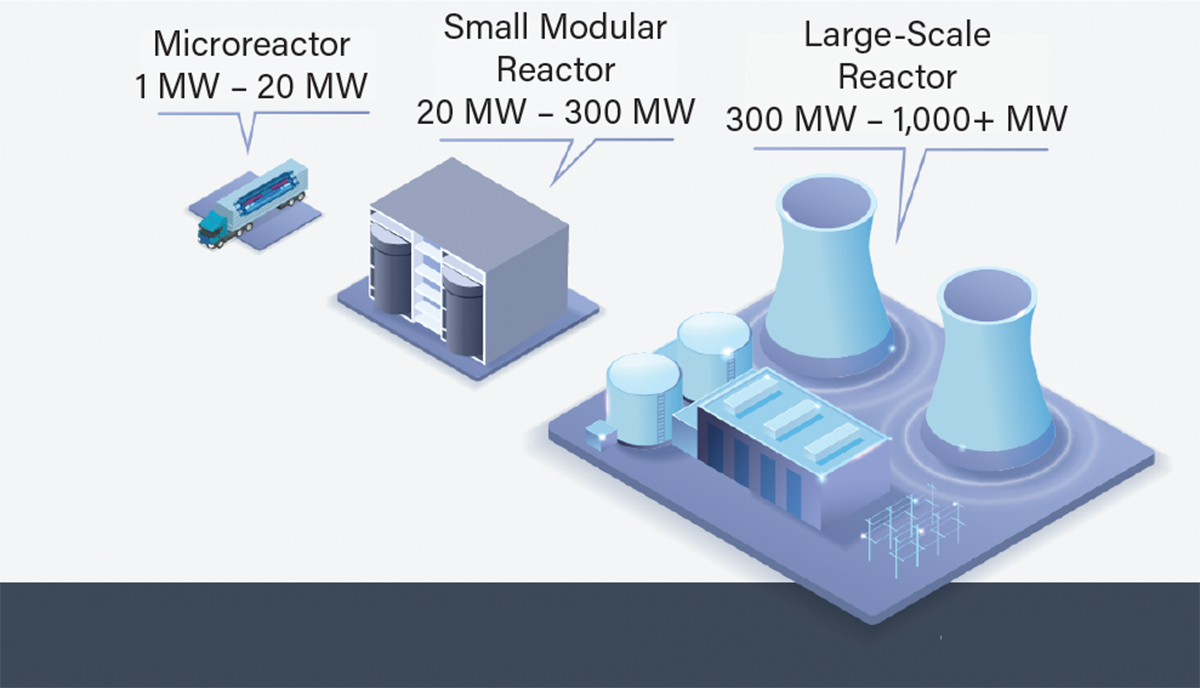Nuclear Renaissance: Powering Tomorrow's World with Small Modular Reactors
Nuclear energy renaissance, crucial for combating climate change, has gained prominence. COP 28 stresses its role in achieving net-zero emissions by 2050 & advocates predict tripling global nuclear capacity. New technologies like Small Modular Reactors offer investment prospects in clean energy.

Nuclear energy has emerged as a critical component of the global strategy in an era defined by the urgent need to combat climate change and transition towards sustainable energy solutions. The recent United Nations Conference of the Parties (COP) 28 declaration, signed by more than 20 countries across four continents, underscores the pivotal role of nuclear energy in achieving net-zero greenhouse gas emissions by 2050 and limiting the rise in global temperatures to 1.5°C.
It emphasizes the necessity to triple (3x) the global installed nuclear energy capacity by 2050 to meet climate goals effectively. Furthermore, countries acknowledge the potential of new nuclear technologies, such as small modular reactors (SMRs), to complement renewable energy sources and support decarbonization efforts across various sectors.
We explore the potential of the SMR market, with their innovative design and enhanced safety features, which offer promising avenues for investment in the evolving energy sector.
Why Nuclear Now?
Historically, nuclear power contributes approximately 10% of global electricity generation, increasing to nearly 20% in developed economies, according to the International Energy Agency. It has consistently been among the largest sources of carbon-free electricity worldwide. Despite facing challenges in certain regions, nuclear power holds considerable promise in advancing the decarbonization of the power sector.
As global population growth drives increased energy demand, particularly with finite resources like fossil fuels, addressing environmental impacts, energy security, and disparities in energy access necessitates a holistic approach to energy supply solutions. The holistic approach will need to prioritize sustainable energy development, efficient resource management, technological innovation, and equitable energy access to meet the needs of a growing population while safeguarding the planet for future generations.
As a result, more than 20 countries, such as the United States, the United Kingdom, France, and Canada, across four continents have launched a declaration recognizing the pivotal role of nuclear energy in achieving global net-zero greenhouse gas emissions by 2050. The commitment calls on other countries to join in recognizing the importance of nuclear energy and contributing to global efforts to achieve net-zero emissions and limit temperature rise.
Participating countries have committed to ensuring a responsible operation of nuclear power plants, adhering to the latest and highest standards of safety, sustainability, security, and non-proliferation. Additionally, they pledge to mobilize investments in nuclear power and support the development of advanced reactors for wider industrial applications.
What is a Small Modular Reactor?
The International Atomic Energy Agency (IAEA) defines 'small' nuclear reactors as under 300 MWe (Megawatt electrical) or less, designed with modular technology using module factory fabrication.
To put the size of a 300 MWe reactor into perspective, consider that 300 MWe is equivalent to generating enough electricity to power approximately 300,000 homes. This amount of power is substantial, providing energy to a medium-sized city or a large industrial complex. For example, a single 300 MWe reactor could supply the electricity needs of a city the size of Anaheim, California with a population of approximately 350,000 people.
United States Department of Energy Explains Small Modular Reactors
SMRs, smaller in capacity compared to traditional reactors, present several advantages:
- Reduced Capital Costs: SMRs are smaller in size compared to traditional large-scale reactors, which leads to lower capital costs for construction and operation, which makes projects more affordable.
- Flexibility and Scalability: SMRs can be deployed in a modular fashion, allowing for incremental capacity additions as needed. This makes them suitable for a wide range of applications, including remote communities, small electricity grids, hydrogen development, and district heating networks.
- Enhanced Safety Features: SMRs are designed with a high level of passive or inherent safety features, reducing the need for active safety systems and additional pumps. Their smaller size also means a higher surface area to volume ratio, which improves heat removal and reduces the risk of accidents.
- Shorter Construction Times: The modular design of SMRs allows for factory fabrication of components, leading to shorter construction times compared to large-scale reactors. This can help expedite the deployment of nuclear power plants.
- Compatibility with Brownfield Sites: SMRs can be deployed on brownfield (i.e. existing use) sites, replacing decommissioned coal-fired plants. This allows for the utilization of existing infrastructure and grid connections, reducing costs and environmental impact.
- Improved Standardization and Quality Control: The modular design of SMRs enables standardized manufacturing processes and higher quality control, leading to improved construction quality and efficiency.
- Enhanced Security: Some SMRs can be located below ground level, providing additional protection against natural and man-made hazards, such as storm events or aircraft impacts.
- Potential for Local Economic Development: The development and deployment of SMRs can stimulate local economies, creating jobs and attracting investment in the nuclear energy sector.
It is important to note that the advantages listed above are general benefits associated with SMRs. The specific advantages may vary depending on the design and technology of the SMR being considered.

Market Potential and Growth:
Analysis from the International Organisation for Economic Co-operation and Development (OECD) Nuclear Energy Agency, the World Nuclear Association, and the Intergovernmental Panel on Climate Change, suggests that global installed nuclear energy capacity must triple (3x) by 2050 to achieve net-zero emissions and meet climate goals. The COP 28 declaration acknowledges the potential of new nuclear technologies, such as SMRs, to complement renewable energy sources and support decarbonization efforts across various sectors beyond power generation.
The market potential for SMRs is difficult to determine precisely but it is expected to grow due to their potential benefits, including enhanced safety features, flexibility in deployment, and potential for cost-effectiveness. Estimates suggest the global market for SMRs could be worth billions of dollars over the next few decades, with projections ranging from $250 billion to $500 billion by 2040.
Environmental Status
The environmental impacts of SMRs can vary depending on the specific design and fuel used. However, there are several potential environmental benefits associated with SMRs compared to traditional large-scale nuclear reactors.
- Smaller land footprint: SMRs are designed to be smaller in size and have a smaller land footprint compared to traditional reactors. This can help minimize the impact on natural habitats and reduce land use requirements.
- Improved safety features: Many SMR designs incorporate passive safety features, such as natural circulation of coolant and inherent shutdown mechanisms. These features can enhance safety and reduce the risk of accidents or releases of radioactive materials.
- Enhanced waste management: Some SMR designs, such as molten salt reactors, have the potential to reduce the volume and long-term toxicity of nuclear waste. These reactors can potentially consume or transmute long-lived radioactive isotopes, reducing the need for long-term storage.
- Flexibility and modularity: SMRs can be deployed in a modular fashion, allowing for more flexible and scalable energy generation. This can help integrate renewable energy sources and provide reliable power in remote or off-grid locations.
It is important to note that the environmental impacts of SMRs will also depend on factors such as the specific location of the reactor, the management of nuclear waste, and the overall energy system in which the SMR is integrated. Additionally, the construction and decommissioning of SMRs will still require careful consideration of environmental impacts, including the potential for habitat disruption, water use, and waste management.
Government Support
Currently, Government support is driving the development of SMRs. Government commitments include substantial funding for SMR research, development, and deployment initiatives. A summary of some of the key drivers:
- The recent United States Infrastructure Investment and Jobs Act (IIJA) provides $8 billion of funding for advanced nuclear reactor investments.
- The United States Department of Energy allocated $452 million over five years through the SMR Licensing Technical Support program to support the development of one or two US light-water reactor designs.
- The United States Inflation Reduction Act (IRA) of 2022 introduces a tax credit for zero-emission clean energy technologies, such as advanced reactors, which refers to advanced nuclear reactors, including modular reactors with $150 million for R&D and $700 million for advanced fuel that offers improved reactor economics, greater fuel efficiency, enhanced safety and proliferation resistance, and lower volumes of waste.
- Under the France 2030 national investment plan, the French government will allocate €1 billion for research and development initiatives focused on advancing domestic SMR technologies.
- The UK government invested at least £250 million over five years in nuclear R&D, including SMRs.
- China is starting to build the 210 MWe HTR-PM, which consists of twin 250 MWt high-temperature gas-cooled reactors.
Power Up Your Portfolio with Nuclear Potential
In conclusion, the emergence of SMRs presents an interesting opportunity for investors to contribute to the transition toward a sustainable energy future. With their innovative design, enhanced safety features, and potential for significant market growth, SMRs offer promising avenues for future investment in the evolving energy sector, as governments worldwide pledge support for nuclear energy and its role in addressing climate change. This is an opportunity to invest in the nuclear potential for tomorrow.
Fun Fact
Did you know that small modular nuclear reactors have the potential to revolutionize space exploration? Some designs are compact and efficient enough to provide power for long-duration missions to distant planets or even for establishing bases on the Moon or Mars. With their ability to generate electricity in harsh environments and remote locations, small modular reactors could play a vital role in powering humanity's future endeavors beyond Earth's atmosphere.
Free Newsletter Content
Twice a month with our newsletter distribution, we will discuss the market trends in one of our six themes below:
1. Renewable Energy (think solar, wind, hydroelectric)
2. Resources (think hydrogen)
3. Circular Economy (think water)
4. Energy Storage (think battery power grid)
5. Carbon Capture and Storage (think Carbon dioxide CO2 capture)
6. Green Transportation (think electric vehicles)
Premium Newsletter Summary
With paid Premium content, you can access our select investments now. They are ready to invest today with no minimum investment amounts and they are accessible in established liquid stock markets to easily buy or sell your investments at any time. Make it your monthly habit!
We also include their Environmental, social, and governance (ESG) score. The ESG data focuses on sustainability, diversity, human rights, license to operate, business ethics, and corporate governance. Using 630 metrics, ESG scores provide a comparison of a company's practices with their industry peers. The higher the score the better the company in their peer group.
Return Habit donates 2% of annual profits to underserved communities for green jobs and education. These jobs and training are critical for our community and economy.
Refer to www.returnhabit.com for our terms and conditions.

